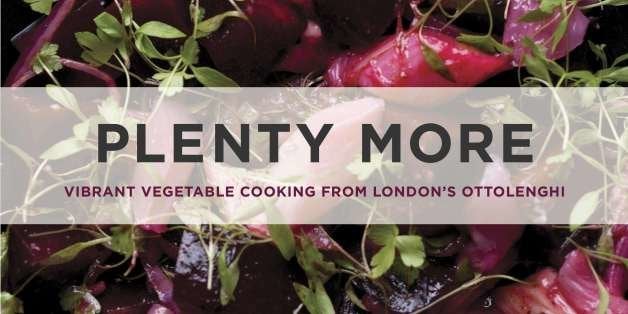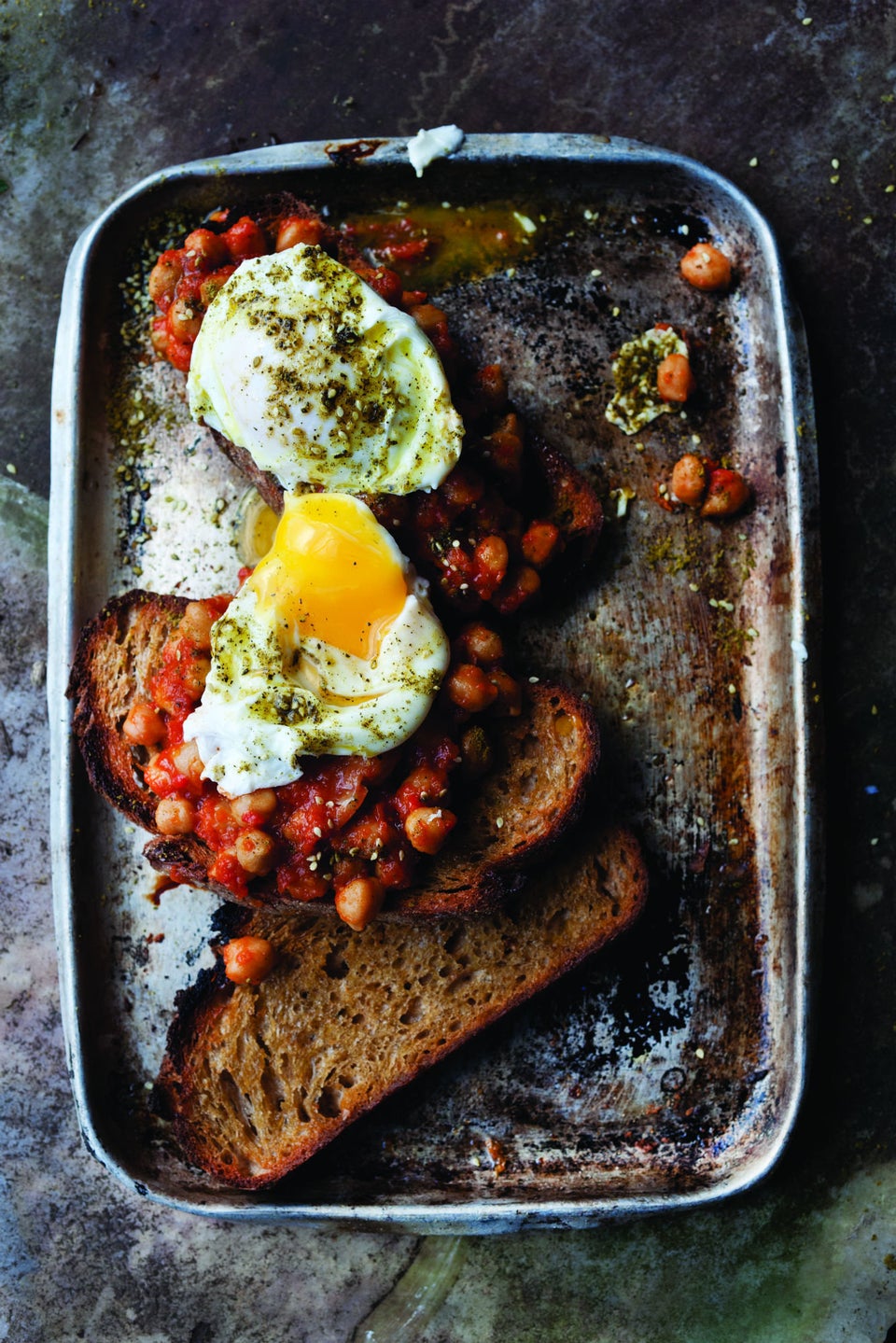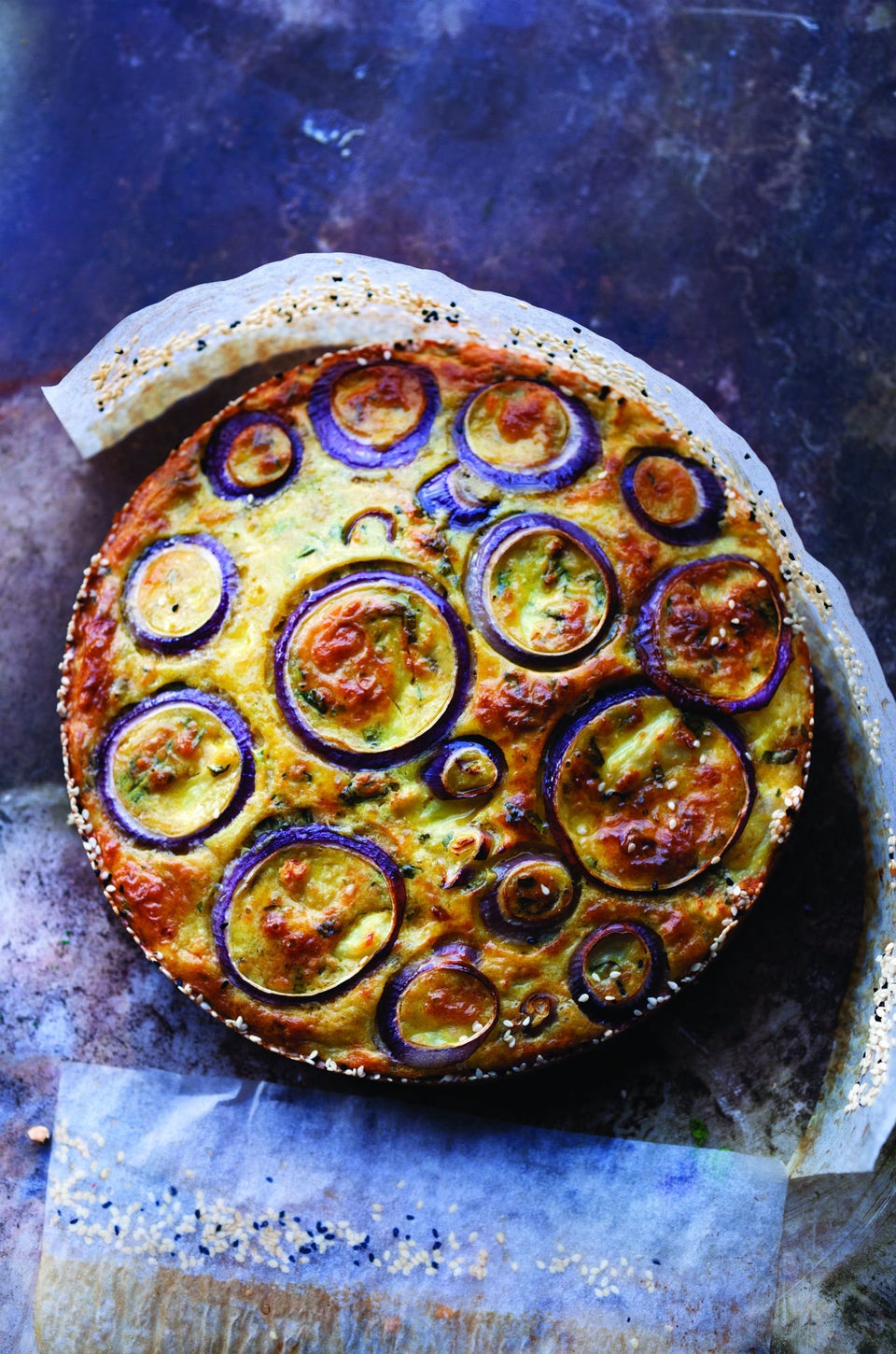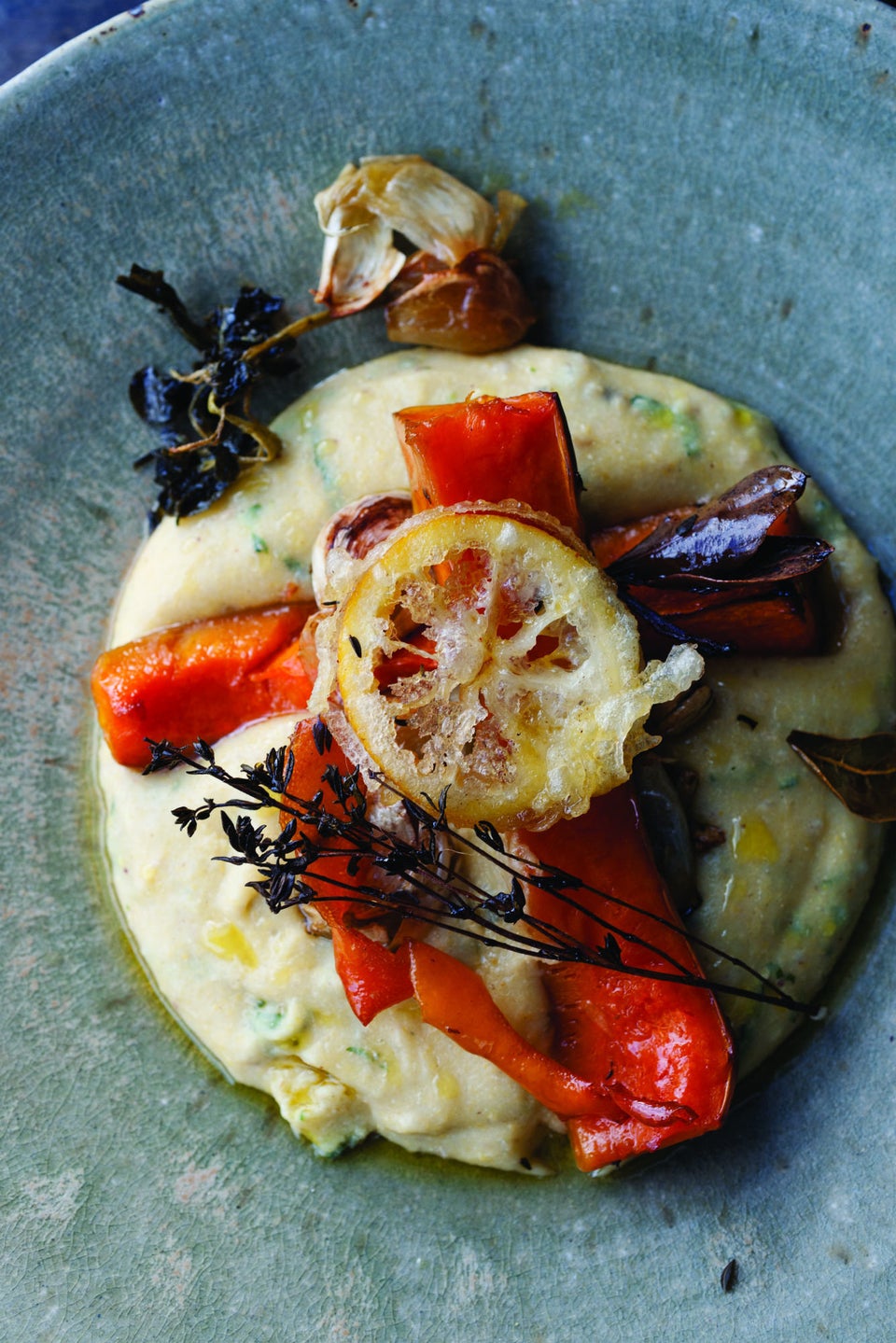
By now it's no secret that the editors at HuffPost Taste are groupies fans of UK chef Yotam Ottolenghi. It's not because of the food he serves at his great restaurants -- which is amazing -- but more for the cookbooks he pens. Through his tomes, Ottolenghi makes us feel like more accomplished cooks in our own kitchens, ones full of culinary creativity and wit.
Ottolenghi's newest cookbook "Plenty More" -- which you can buy on Amazon -- has been in the works for some time now, and we've been waiting for it with bated breath. We got our hands on it and discovered it was more than worth the wait. This cookbook holds all the splendor of "Plenty" and yet feels like a completely new experience. In its 332 pages, it has confirmed our suspicions that Ottolenghi is in fact a master of vegetables.
We chatted with our vegetable hero about his new book, his favorite recipes, and of course, eggplant. Read on to hear the inspiring words from the man himself (plus find a few great recipes he shared with us below):
You've written countless vegetable-forward recipes, how do you come up with new ideas? Where do you find your inspiration?
I used to think that a vegetarian remit for a recipe would be limiting but that’s not been the case at all. Vegetables are so much more versatile than they are often given credit for. It’s easy to typecast vegetables -– eggplant gets roasted, broccoli gets steamed, cabbage gets boiled, zucchini gets pan-fried – but there’s a whole cast of characters out there, waiting to get given a different and often more exciting role.
Some of my favorite recipes in the book are those which take a totally everyday vegetable and, through cooking it in a new way, show it in a completely new light. Roasting a zucchini as you normally would an eggplant, for example, to make a “baba ganoush.” Chargrilling baby tomatoes, steaming a whole eggplant, slow-cooking a white cabbage for four hours, braising a little gem lettuce which normally never sees the heat. Once you start playing around with cooking methods like this, the new ideas just keep coming.
It’s not just my own experimenting though, I pour through recipe books a lot to get ideas or I’ll fall for something I have eaten and that will spark an idea. I also take a lot of inspiration from the Ottolenghi and NOPI restaurant chefs, who come up with tons of new ideas and new takes on the old classics.
How do you feel the collection of recipes from "Plenty More" compares to the collection in "Plenty?"
All my books are incredibly special to me in different ways: it’s rather like having four very different children, I imagine. "Plenty More" is like "Plenty's" younger precocious sibling, knowing how confident, assertive and colorful they need to be to get their voice heard at the table. The family roots are still there but they’re sometimes shaken up by dancing to a different tune –- "I wanna be braised, not baked" -– or by the appearance of the new kids on the block. Black garlic, sea spaghetti, dried Iranian lime, Dakos biscuits, these are just some new ingredients for me which all play together with the vegetables -- and other ingredients I fell for -- when writing "Plenty."
What advice would you give a novice cook who is exploring your recipes in "Plenty More"?
Don’t be put off by a list of ingredients which is longer than you might be used to. Just because it is long, it doesn’t mean it’s complicated! Although I struggle to defend myself against the "how many ingredients?!" exclaim, I really do defend the simplicity of the vast majority of my recipes. I like a vegetable to remain as close to its natural state as I can –- quickly blanched broccoli, carrots cut into a shape where they still look like carrots –- so I actually think there’s a real simplicity inherent in my recipes.
But in terms of rock solid advice, I’d say prepare as much as you can in advance, so that you don’t get in a twist. Taste the food as you are making it, so that you can relax in the knowledge that it’s delicious. And don’t do it unless it’s making you happy -- food made in a grump never quite works the way you planned. [Wise words.]
What are some of your favorite dishes to cook at home?
I tend to cook on the weekends and the weekends are all about comforting food for friends and family so, from "Plenty More," it’s a lot of the sorts of dishes in the baked chapter. The baked orzo, for example, or ricotta and rosemary bread pudding, paired with a few lighter salads like the tart apple and celeriac salad or the crunchy root vegetables.
Do you have any special or "secret" ingredients you turn to in your kitchen?
Tamarind paste made from the actual pulp (rather than buying a ready-made variety) and white or brown miso. I’m not very good at keeping my culinary secrets, though, so I’ve been raving about how good these are for injecting tons of savory flavor into your cooking for quite a while now. Lemon juice, Greek yogurt and olive oil are also reliably special when a dish needs that final ta-da!
You seem to really enjoy cooking with vegetables, do you have a favorite?
I’m rather fickle when it comes to this one I’m afraid, with a different favorite for every week of the year. At the moment I’m feeling the love for the often-neglected or thought-of-as-unsexy vegetables like turnips, leeks, rutabaga and celeriac. Some of my favorite dishes in recent weeks have had this bunch as their star player -- wedges of turnip roasted in harissa, for example, was incredibly hard to stop eating.
Let's talk about eggplant. It's one of those vegetables that some people have trouble with, any tips for the novice?
A nice hot oven, lots of seasoning and olive oil – eggplant is thirsty! – a sharp knife to cut some nice thick round slices and a baking tray lined with parchment paper so they don’t get stuck.
And now, for the oh-so-beautiful vegetable recipes we promised. Enjoy!
The following excerpts are from "Plenty More: Vibrant Vegetable Cooking from London's Ottolenghi" by Yotam Ottolenghi/Ten Speed Press, 2014.

Notwithstanding the cooking time, it’s a very low-maintenance and highly comforting dish; one to simmer away on the stove some weekend when you are puttering about in slippers at home. It tastes fantastic the next day and the day after that, so you might want to double the quantities and keep a batch in the fridge. A spoonful of Greek yogurt can be served alongside each portion, if you like.
Serves 4
1 cup/220 g dried chickpeas, soaked in water over night with 2 tsp baking soda
1 tbsp olive oil, plus 1 tbsp to finish
1 medium onion, coarsely chopped (about 1 cup/140 g)
3 cloves garlic, crushed
1½ tsp tomato paste
¼ tsp cayenne pepper
¼ tsp smoked paprika
2 medium red peppers, cut into ¼-inch/5-mm diced (about 1¼ cups/180 g)
1 beefsteak tomato, peeled and coarsely chopped (12/3 cups/300 g)
½ tsp superfine sugar
4 slices sourdough bread, brushed with olive oil and grilled on both sides
4 eggs, freshly poached
2 tsp za’atar
salt and black pepper
Drain and rinse the chickpeas and place them in a large saucepan with plenty of water. Place over high heat, bring to a boil, skim the surface, and boil for 5 minutes. Drain and set aside.
Place the oil, onion, garlic, tomato paste, cayenne, paprika, red peppers, 1 teaspoon salt, and some black pepper in a food processor and blitz to form a paste.
Wipe out the chickpea saucepan, return it to the stove over medium heat, and add the paste. Fry for 5 minutes (there’s enough oil there to allow for this), stirring occasionally, before adding the tomato, sugar, chickpeas, and a scant 1 cup/200 ml water. Bring to a low simmer, cover the pan, and cook over very low heat for 4 hours, stirring from time to time and adding more water when needed to retain a sauce-like consistency. Remove the lid and cook for a final hour, the sauce needs to thicken without the chickpeas becoming dry.
Place a piece of warm grilled bread on each plate and spoon the chickpeas over the bread. Lay a poached egg on top, followed by a sprinkle of za’atar and a drizzle of oil. Serve at once.

Serve this cake as a light supper alongside a makeshift salad of sliced cucumber, dill, mint, a little sugar, cider vinegar, and canola oil. Wrapped well, this cake will taste even better the next day.
Serves 4-6
1 small cauliflower, outer leaves removed, broken into 1¼-inch/3-cm florets (1 lb/450 g)
1 medium red onion, peeled (6 oz/170 g)
5 tbsp/75 ml olive oil
½ tsp finely chopped rosemary
7 eggs (scant 1 lb/440 g)
½ cup/15 g basil leaves, chopped
1 cup/120 g all-purpose flour, sifted
1½ tsp baking powder
1/3 tsp g round turmeric
5 oz/150 g coarsely grated Parmesan or another mature cheese
melted unsalted butter, for brushing
1 tbsp white sesame seeds
1 tsp nigella (fennel) seeds
salt and black pepper
Preheat the oven to 400ºF/200ºC.
Place the cauliflower florets in a saucepan and add 1 teaspoon salt. Cover with water and simmer for 15 minutes, until the florets are quite soft. They should break when pressed with a spoon. Drain and set aside in a colander to dry.
Cut 4 round slices, each ¼ inch thick, off one end of the onion and set aside. Coarsely chop the rest of the onion and place in a small pan with the oil and rosemary. Cook for 10 minutes over medium heat, stirring from time to time, until soft. Remove from the heat and set aside to cool. Transfer the onion to a large bowl, add the eggs and basil, whisk well, and then add the flour, baking powder, turmeric, Parmesan, 1 teaspoon salt, and plenty of pepper. Whisk until smooth before adding the cauliflower and stirring gently, trying not to break up the florets.
Line the base and sides of a 9½-inch springform cake pan with parchment paper. Brush the sides with melted butter, then mix together the sesame and nigella seeds and toss them around the inside of the pan so that they stick to the sides. Pour the cauliflower mixture into the pan, spreading it evenly, and arrange the reserved onion rings on top. Place in the center of the oven and bake for 45 minutes, until golden brown and set; a knife inserted into the center of the cake should come out clean. Remove from the oven and leave for at least 20 minutes before serving. It needs to be served just warm, rather than hot, or at room temperature.

Serves 6
Butternut
1 large butternut squash (1.3 kg)
3 tbsp olive oil
1½ tbsp/25 g unsalted butter, diced
1¼ cups/300 ml vegetable stock
3 oregano sprigs (1/3 oz/10 g)
15 black peppercorns
8 allspice berries
6 cardamom pods, crushed
6 bay leaves
6 thyme sprigs
rind of 1 large orange shaved in long, narrow strips
8 cloves garlic, lightly cracked with the skin on
salt
Polenta
3 tbsp/30 g roasted buckwheat (kasha) or buckwheat groats
2/3 cup/150 ml whole milk
3¾ cups/900 ml vegetable stock
1/3 cup/10 g oregano leaves, coarsely chopped
1 bay leaf
1 tbsp thyme leaves
Shaved rind of ½ lemon
¾ cup/120 g polenta
¼ cup/60 g unsalted butter salt and white pepper
Tempura lemon
4½ tbsp/35 g flour
3 tbsp plus 1 tsp/25 g cornstarch
5 tbsp/75 ml cold soda water
sunflower oil, for frying
1 lemon, cut crosswise into 1/8-inch -/3-mm-thick slices salt
Preheat the oven to 400ºF/200ºC. Trim the top and bottom off the butternut and halve lengthwise. Scoop out and discard the seeds and cut each half into 3 long wedges, skin on. Place the wedges in a large roasting pan with all the remaining squash ingredients and ¾ teaspoon salt, coating the butternut well with the aromatics. Bake for 50 minutes, turning the butternut pieces every 10 minutes or so and spooning the juices over them, until the squash is cooked, golden brown, and starting to crisp on top. Add a little stock during cooking if the pan is drying out.
Meanwhile, to make the polenta, put the kasha in a small baking pan and toast in the oven at the same time as the squash for 5 minutes, or 10 minutes for plain groats. Remove and crush lightly with a pestle and mortar.
In a large saucepan over high heat, combine the milk, stock, herbs, lemon rind strips, ¾ teaspoon salt, and a pinch of white pepper. Bring to a boil and then turn the heat to low and whisk in the polenta and buckwheat. Using a wooden spoon, stir every few minutes for 35 to 40 minutes, until the polenta is thick and cooked. If it is getting too thick, add a little water. At the end of the cooking, stir in the butter. The polenta should be thick but runny enough to fall off the spoon easily. Cover the top of the polenta with plastic wrap to stop a skin from forming and leave somewhere warm.
To make the tempura, mix together the flour and cornstarch, then whisk in the soda water until the mixture is smooth and runny. Sit the bowl over ice for 45 minutes.
Pour oil to a depth of 1¼ inches/3 cm into a saucepan and heat to about 320ºF/160ºC. Dip the lemon slices into the batter and fry for 2 to 3 minutes, until golden and crispy. Remove with a slotted spoon and sprinkle immediately with salt.
Place a spoonful of warm polenta on each plate and lay a squash wedge across it, adding a mix of the baked aromatics on top. Finish with a tempura lemon slice and serve at once.
***
Before you delve into Ottolenghi's recipes, you might have to hunt down some hard-to-find ingredients. We've located a handful of them in the slide show below so that you don't waste any time before getting started on his recipes.
You are welcome.
